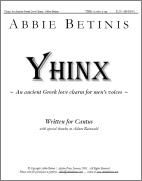Yhinx: An Ancient Greek Love Charm
Voicing: TTBB a cappella, t.b. solos, solo whistlerText: Theocritus (3rd cent. BC), Greek stone (3rd cent. AD). Trans. by J.M. Edmonds (1912)
Language: Greek and English
Duration: 4 min.
Premiere: Cantus; Minneapolis, MN - May 8, 2003
Published by: Abbie Betinis Music Co., AB-018-01
See the score: PREVIEW THE SCORE (pdf)
REVIEW:
- Rob Hubbard. St. Paul Pioneer Press (July 2019).
LISTEN:
Performed live by the University of Minnesota Men's Chorus; Bryce Hayes, conductor
Yhinx: An Ancient Greek Love Charm mp3, 4:00, 3.7 MB
Performed live by Cantus
PROGRAM NOTE:
Yhinx, written for Cantus's spring 2003 concert series "Magic, Myth, and Legend," melds together two ancient Greek love charms for an energetic setting of the evocative texts. The yhinx (spelled "Iunx" in Greek, and now known as a "jinx") is an ancient Greek spell which requires a spinning brass disk bound with a wryneck bird. It is specifically an "erotic binding spell" meant to freeze a wayward lover in any sinful act, then return the lover to the one casting the spell.
The text here is from two ancient Greek sources. The verses are from Theocritus's Idyll II, written in the 3rd century BC. In it, the narrator, Simaetha, lays a binding spell onto her neglectful lover. She burns barley-meal, bay leaves, bran, and a waxen puppet upon an altar, then demands that the maid, Thestylis, secretly smear the ashes above her absent lover's doorway. True to the much longer English translation by J.M. Edmonds (1912), this musical setting uses whistling, spitting, and the vocal equivalent of the beating of drums to evoke the mysticism of the event. I also added voiced shadow vowels ("charms-zah!") for extra drama.
The second source of text is from a stone recently discovered in Egypt which contains the following string of Greek letters:
![]()
Like the Theocritus text, it is thought to be a binding "yhinx" spell, dating from the 3rd century AD. Because these 39 letters can be read the same way backward and forward, much of the melodic and rhythmic figures in Yhinx are written symmetrically. The first half of the refrain, for instance, is from an ancient Hymn to Apollo (incidentally the twin of Artemis, who Simaetha entreats), while the second half is its retrograde. Many of the 7/8 figures are subdivided symmetrically as 3+2+2 / 2+2+3. The mixed meter, a feature of Greek music, is superimposed in symmetrical rhythms to match the mystical palindromic structure of the yhinx.
But does the spell work? In the hope that there may have been some truth to these awkward syllables, only in the very last statement of the chorus does the inversion of the chant appear. Finally the chant has turned itself upside down - and hopefully the lover returns home!
- Abbie Betinis, 2003
TEXT:
![]() (Now, now, quickly quickly)
(Now, now, quickly quickly)
![]()
First Barley meal to the burning, Come, Thestylis! Throw it on! On, on with the meal! So I burn the bay, As it crackles and then - Lo!
Now for the bran... "O Artemis! Artemis!" Whelmed in the flames! Hark Thestylis! Quick - beat the pan!
So melt my Love so speedily -
And as this wheel of brass
Turns by grace of Aphrodite,
So (my Love shall) turn and turn again...
Lo there! Now wave is still and wind is still, though never still the pain burning in my breast. For I am all afire, afire alas! So take thou these ashes, come Thestylis, while tis yet dark, and smear them privily, and spit for what thou doest and... Thrice this libation I pour - Thrice this prayer... "O Artemis, Artemis!" Thrice I say to Thee:
![]()
Theocritus (3rd century BC), with English translation by J. M. Edmunds (1912), and Greek stone (3rd century AD). These texts, to the best of my knowledge, are in the public domain, and may be reprinted from this website for use in concert programs and for promotional use as related to this musical work.
PRONUNCIATION KEY FOR ANCIENT GREEK:
Hey-dey, hey-dey, tah-ku, tah-ku (Now, now, quickly quickly!)
Yheunx: ah-behr-ah-men-thoh-oo-lehr-thex-ah-na-kseth-rehl-oo-oh-thnem-ah-reh-bah
I prefer the "Yh" of Yhinx is an aspirated Y sound, with the tongue close to the roof of the mouth. All vowels are pure (like Latin vowels). The exception is the "i" in "Yhinx" which (because it is "u" in the Greek) may be more similar to the pointed French "eu." R's should be rolled or trilled. Because the chant is thought to be a nonsense word, there is no specific text stress.
Cantus
University of Minnesota Men's Chorus (Bryce Hayes, conductor)
(Have you performed this piece? Add your performance!)

